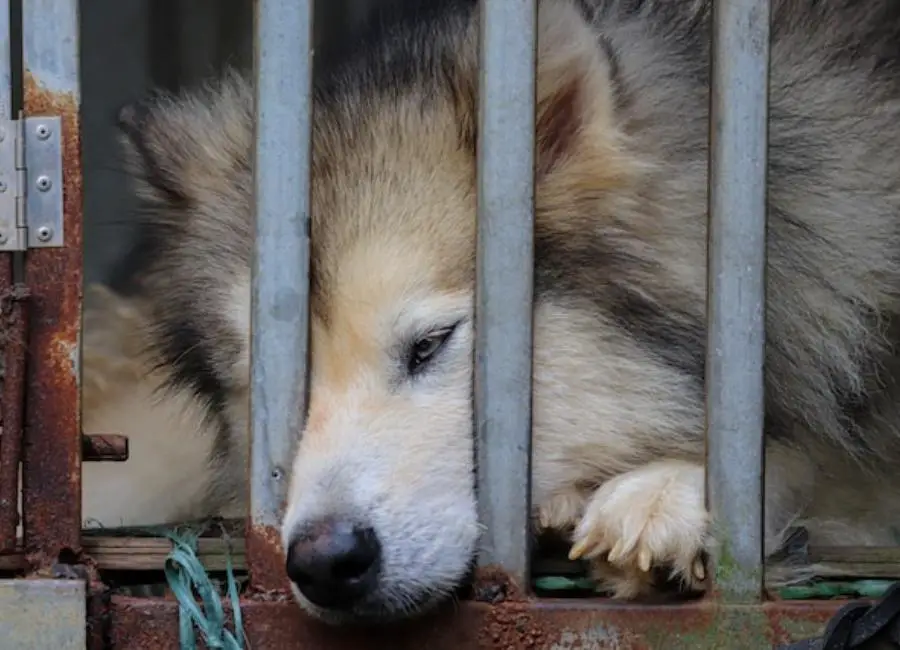Why does my dog cry so much? Let’s find out together…
Ever wondered why your furry friend seems to shed more tears than you do during a sad movie?
If your dog’s constant crying has you feeling like you’re living in a canine soap opera, fret not!
In this blog post, we’ll dive into the reasons behind your pup’s waterworks and explore some tips to help them find their inner happiness.
Why Does My Dog Cry So Much
From my experience as a dog owner, dogs may cry due to various reasons, including separation anxiety, fear or distress, medical issues, or attention-seeking behavior.
Separation anxiety occurs when dogs become anxious or stressed when left alone. Fear or distress can be caused by loud noises, unfamiliar environments, or traumatic experiences.
Medical issues such as pain, discomfort, or illness can also lead to excessive crying. Lastly, some dogs may cry to get attention or to communicate their needs.
It is important to observe your dog’s behavior and consult with a veterinarian or professional dog trainer to determine the underlying cause of the excessive crying.
Let’s dig deeper…
Reasons Why Your Dog May Cry

From my experience living with dogs for many years, here are some of the most common reasons why your dog might be crying:
1. Aging and Cognitive Dysfunction
Aging can lead to cognitive dysfunction in dogs, which can manifest as increased vocalization or crying.
This condition, often referred to as canine cognitive dysfunction (CCD), is similar to Alzheimer’s disease in humans.
CCD is characterized by cognitive decline, memory loss, disorientation, and changes in behavior.
To address this issue it is important to provide a stimulating environment that includes regular exercise, mental stimulation, and a consistent routine.
Puzzle toys, interactive games, and obedience training can help keep their minds engaged.
Creating a calm and comfortable space, using pheromone diffusers, and providing a predictable schedule can also help reduce anxiety and confusion.
Consulting with a veterinarian for a thorough evaluation and possible medication options is recommended for managing CCD in dogs.
2. Loneliness and Separation Anxiety
Loneliness and separation anxiety can be common reasons why dogs may cry. Dogs are social animals and rely on the companionship and attention of their owners.
When left alone for extended periods, they can feel isolated and anxious, leading to crying or excessive vocalization.
To address this issue it is important to provide your dog with mental and physical stimulation. Engage in regular exercise and playtime to expend their energy.
Additionally, consider crate training your dog to provide them with a safe and secure space when you are away.
Establishing a consistent routine and gradually increasing the duration of time spent apart can help alleviate separation anxiety.
Leave your dog with interactive toys or treat puzzles to keep them occupied during your absence.
3. Hunger and Thirst
Hunger and thirst can be one of the reasons why dogs may cry. When dogs are hungry or thirsty, their natural instinct is to vocalize their needs.
This can manifest as whining, whimpering, or even barking. To address this issue it is important to ensure that your dog has access to fresh water at all times and is fed regular, balanced meals.
Establishing a feeding schedule and portion control can help regulate your dog’s hunger and prevent excessive crying.
Additionally, providing mental stimulation and engaging in regular exercise can help distract your dog from focusing solely on their hunger or thirst.
4. Need for Bathroom Break
Dogs may cry or whine as a way of expressing their need for a bathroom break. This happens because dogs, like humans, have bodily functions that require regular elimination.
As an experienced dog owner, it is important to recognize the signs that indicate your dog needs to relieve themselves.
These signs may include restlessness, pacing, sniffing around, or scratching at the door. To address this issue at home, establish a regular bathroom schedule for your dog, taking them outside at consistent intervals.
Additionally, provide easy access to an outdoor potty area and reward your dog with praise or treats when they successfully eliminate outside.
Consistency and positive reinforcement will help establish good bathroom habits and reduce crying or whining associated with bathroom needs.
5. Fear and Anxiety
Fear and anxiety can be a reason why dogs cry. This can happen when dogs feel threatened or overwhelmed by certain situations or stimuli.
It is important to identify the triggers that cause fear and anxiety in your dog, such as loud noises, unfamiliar environments, or certain people or animals.
Once you have identified the triggers, you can work on desensitizing your dog to them through gradual exposure and positive reinforcement.
Creating a safe and comfortable environment at home is crucial, providing your dog with a designated space where they can retreat when they feel anxious.
Additionally, engaging in regular exercise and mental stimulation can help reduce anxiety in dogs and promote overall well-being.
As an experienced dog owner, it is essential to be patient, understanding, and consistent in addressing your dog’s fear and anxiety, seeking professional help if needed.
6. Pain or Discomfort
Dogs may cry or express pain/discomfort for various reasons, including physical injuries, illness, or emotional distress.
Physical injuries such as sprains, fractures, or wounds can cause dogs to cry due to the associated pain.
Illnesses like arthritis or urinary tract infections can also lead to discomfort and crying.
Emotional distress, such as separation anxiety or fear, can also cause dogs to cry.
As a dog owner, addressing these issues at home involves observing the dog’s behavior, looking for signs of pain or discomfort, and seeking veterinary care if necessary.
Providing a comfortable and safe environment, ensuring proper nutrition and exercise, and offering mental stimulation can also help alleviate pain and discomfort in dogs.
7. Attention-seeking
Attention-seeking is a common reason why dogs may cry. Dogs learn that crying can garner attention from their owners.
This behavior may manifest in various ways, such as barking, whining, or pawing at their owners.
To address this issue, experienced dog owners need to provide consistent and clear boundaries.
Ignoring the crying behavior and not rewarding it with attention is crucial. Instead, rewarding the dog when they are calm and quiet will reinforce positive behavior.
Engaging in regular exercise and mental stimulation can also help reduce attention-seeking behavior.
Consistency, patience, and positive reinforcement are key in addressing attention-seeking crying in dogs.
8. Boredom or Lack of Mental Stimulation
Boredom or lack of mental stimulation can be a reason why dogs may cry. When dogs don’t have enough mental stimulation, they can become restless and bored, leading to behaviors like excessive crying.
To address this issue you can provide your dog with various mental enrichment activities.
These activities can include puzzle toys, interactive games, and training sessions.
Additionally, incorporating regular exercise and playtime into your dog’s routine can help alleviate boredom and provide mental stimulation.
Creating a structured daily schedule and ensuring your dog has plenty of social interaction with other dogs or humans can also prevent boredom-related crying.
9. Frustration
Frustration can be a significant reason why dogs cry, often resulting from constraints on their natural behaviors or unmet needs.
This can occur when a dog desires something it can’t access, like a toy under the couch, or if it’s confined for too long in a small space.
The dog’s cry is a communication tool expressing its discomfort or distress. As a dog owner, it’s crucial to identify and understand these signs of frustration.
Addressing the issue can involve removing the source of frustration, such as retrieving the unreachable toy or providing more space and freedom.
Regular physical and mental stimulation through exercise and interaction is also essential to mitigate such feelings of frustration in dogs.
10. Temperature Discomfort
Temperature discomfort can be a reason why dogs may cry. Dogs have a different tolerance for temperature compared to humans, and extreme temperatures can cause them distress.
Dogs may cry to express their discomfort and seek relief. To address this issue at home, as a dog owner, there are a few steps you can take.
Firstly, ensure your dog has access to a comfortable and shaded area during hot weather, and provide fresh water at all times.
In colder weather, provide your dog with a warm and cozy shelter, and consider using doggy jackets or booties to protect them from the cold.
Regularly monitor your dog’s behavior and adjust their environment accordingly to ensure their comfort and well-being.
What to do if Your Dog is Crying

If your dog is crying, first check for any visible signs of injury or discomfort, as the crying could indicate physical pain.
If there are no clear signs, consider the possibility of emotional distress, such as separation anxiety or fear.
Provide your dog with a comforting and secure environment, including a familiar blanket or toy.
Engage them in their favorite activities or exercises to distract them and relieve stress.
If the crying persists, it’s important to consult with a veterinarian to rule out any underlying health issues.
Remember, consistent positive reinforcement and patience are key to making your dog feel safe and loved.
Frequently Asked Questions
Why does my dog cry so much when I leave the house?
Separation anxiety is a common reason for excessive crying in dogs. They feel anxious and lonely when you’re away, and crying is their way of expressing distress. Gradually introducing them to alone time and providing them with comforting toys or treats can help alleviate this behavior.
My dog cries when I leave the room even for a minute. What’s going on?
Your dog may have developed a strong attachment to you, known as velcro dog syndrome. They become overly reliant on their owners and feel anxious when separated, even momentarily. Building their independence through positive reinforcement training and gradually increasing alone time can help reduce their crying.
Is my dog crying because they’re in pain?
It’s possible. Dogs may cry or vocalize when they’re in pain or discomfort. If you notice other signs like limping, loss of appetite, or changes in behavior, it’s important to consult your veterinarian. They can assess your dog’s health and determine if there’s an underlying medical issue causing the crying.
My dog cries during thunderstorms. How can I help them?
Many dogs are fearful of thunderstorms, and crying is a common response. Creating a safe space for your dog, such as a designated area with their favorite toys and bedding, can provide comfort. Additionally, using calming techniques like playing soothing music or using a thunder shirt can help reduce their anxiety.
My dog cries excessively when visitors come over. What should I do?
Excessive crying during social interactions can be a sign of excitement or anxiety. Training your dog to have positive associations with visitors through controlled introductions and reward-based training can help. Gradually exposing them to different people and situations can also help reduce their crying.
My dog cries during car rides. Any tips on how to make it more enjoyable for them?
Some dogs experience motion sickness or anxiety during car rides, leading to crying. To make it more enjoyable, start by getting them used to short trips and gradually increasing the duration. Providing them with a comfortable and secure crate or using specialized car harnesses can also help reduce their discomfort and anxiety.
Conclusion
In conclusion, if you find your furry friend crying more often than usual, remember that dogs communicate through various vocalizations, including whining and whimpering. It could be a sign of discomfort, anxiety, or simply a way to grab your attention. Pay close attention to their body language and consult with a veterinarian to address any underlying issues. Remember, a little extra love and understanding can go a long way in soothing your crying canine companion.


